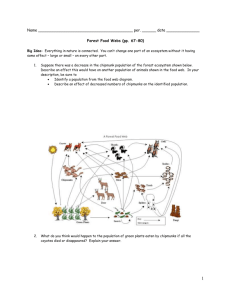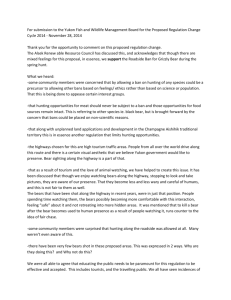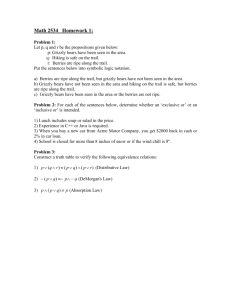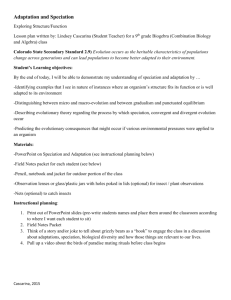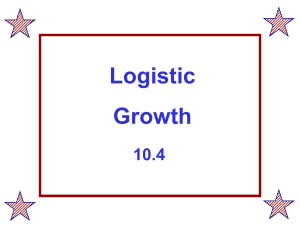insights into the economic value of grizzly bears in the yellowstone
advertisement
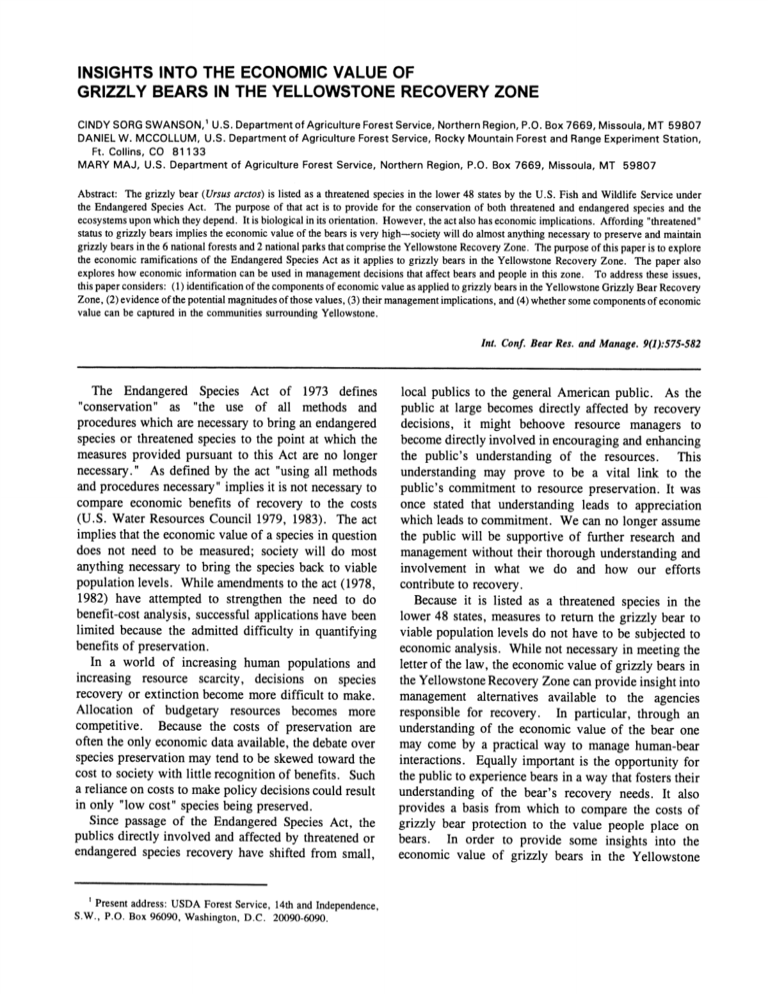
INSIGHTSINTOTHEECONOMIC VALUEOF BEARSINTHEYELLOWSTONE GRIZZLY RECOVERY ZONE CINDYSORGSWANSON,1U.S. Departmentof AgricultureForestService, NorthernRegion,P.O. Box 7669, Missoula,MT 59807 W. MCCOLLUM, DANIEL U.S. Departmentof AgricultureForest Service, Rocky MountainForest and Range ExperimentStation, Ft. Collins, CO 81133 MARYMAJ, U.S. Departmentof AgricultureForest Service, NorthernRegion, P.O. Box 7669, Missoula, MT 59807 Abstract:Thegrizzlybear(Ursusarctos)is listedas a threatened speciesin thelower48 statesby the U.S. FishandWildlifeServiceunder the Endangered of boththreatened andendangeredspeciesandthe SpeciesAct. The purposeof thatact is to providefor the conservation ecosystemsuponwhichtheydepend.Itis biologicalinits orientation.However,theactalsohaseconomicimplications.Affording"threatened" statusto grizzlybearsimpliestheeconomicvalueof thebearsis veryhigh-societywill do almostanythingnecessaryto preserveandmaintain grizzlybearsin the6 nationalforestsand2 nationalparksthatcomprisetheYellowstoneRecoveryZone. Thepurposeof thispaperis to explore the economicramifications of the Endangered SpeciesAct as it appliesto grizzlybearsin theYellowstoneRecoveryZone. The paperalso canbe usedin management decisionsthataffectbearsandpeoplein thiszone. To addresstheseissues, exploreshow economicinformation thispaperconsiders:(1) identification of thecomponents of economicvalueas appliedtogrizzlybearsin theYellowstoneGrizzlyBearRecovery of thosevalues,(3) theirmanagement Zone,(2) evidenceof thepotentialmagnitudes and(4)whethersomecomponents of economic implications, valuecan be capturedin the communities Yellowstone. surrounding Int. Conf. BearRes. and Manage.9(1):575-582 The EndangeredSpecies Act of 1973 defines "conservation"as "the use of all methods and procedureswhicharenecessaryto bringan endangered speciesor threatenedspeciesto the pointat whichthe measuresprovidedpursuantto this Act are no longer necessary." As definedby the act "usingall methods andproceduresnecessary"impliesit is not necessaryto compareeconomicbenefitsof recoveryto the costs (U.S. WaterResourcesCouncil1979, 1983). The act impliesthatthe economicvalueof a speciesin question does not need to be measured;society will do most anythingnecessaryto bringthe speciesbackto viable to the act(1978, populationlevels. Whileamendments 1982) have attemptedto strengthenthe need to do benefit-costanalysis,successfulapplications havebeen limitedbecausethe admitteddifficultyin quantifying benefitsof preservation. In a world of increasinghumanpopulationsand increasing resource scarcity, decisions on species recoveryor extinctionbecomemoredifficultto make. Allocation of budgetary resources becomes more competitive. Because the costs of preservationare oftenthe only economicdataavailable,the debateover speciespreservation maytendto be skewedtowardthe cost to societywith littlerecognitionof benefits. Such a relianceon coststo makepolicydecisionscouldresult in only "lowcost"speciesbeingpreserved. Since passageof the EndangeredSpeciesAct, the publicsdirectlyinvolvedandaffectedby threatened or endangeredspeciesrecoveryhave shiftedfrom small, Presentaddress:USDA ForestService,14thandIndependence, S.W., P.O. Box 96090, Washington,D.C. 20090-6090. local publicsto the generalAmericanpublic. As the publicat largebecomesdirectlyaffectedby recovery decisions, it might behoove resource managersto becomedirectlyinvolvedin encouragingandenhancing the public's understandingof the resources. This understanding may prove to be a vital link to the public'scommitmentto resourcepreservation.It was once statedthat understanding leads to appreciation whichleadsto commitment.We canno longerassume the publicwill be supportiveof furtherresearchand withouttheirthoroughunderstanding and management involvementin what we do and how our efforts contribute to recovery. Becauseit is listed as a threatenedspecies in the lower48 states,measuresto returnthe grizzlybearto viablepopulationlevels do not have to be subjectedto economicanalysis. Whilenot necessaryin meetingthe letterof the law, the economicvalueof grizzlybearsin theYellowstoneRecoveryZonecanprovideinsightinto managementalternativesavailable to the agencies responsiblefor recovery. In particular,throughan of the economicvalue of the bear one understanding may come by a practicalway to managehuman-bear interactions.Equallyimportantis the opportunityfor thepublicto experiencebearsin a way thatfosterstheir of the bear's recoveryneeds. It also understanding a basis from whichto comparethe costs of provides bear grizzly protectionto the value people place on bears. In order to provide some insights into the economicvalue of grizzly bears in the Yellowstone 576 Int. Conf.BearRes. and Manage.9(1) 1994 (1) the Recovery Zone, the paper addresses: components of value associated with grizzly bears, (2) evidence of the magnitude of those values, (3) management implications, and (4) ways the economic value can be captured. Further information on economic valuation as it relates to wildlife can be found in McCollum et al. (1992) and Loomis et al. (1984). Bishop (1978, 1979) provides an economist's perspective on species extinction. COMPONENTSOF ECONOMICVALUE Whetherin New York City or a town like Hamilton, Montana, the mere mention of "grizzlybears"provokes vivid images in the minds of listeners. The images may vary from a close encounter on a wilderness trail to a special segment on National Geographic viewed from the safety of one's own living room. In either case, the image can be put into an economic framework. In the broadest sense, value can be defined as an intangible human attitude whereby people attribute worth or significance to things. Grizzly bear recovery is importantto a wide range of individualsbecause of a variety of personally held values (see Brown 1984). As discussed by Shaw and Zube (1980), those values may have their roots in: (1) marketterms (goods and products measured in dollars), (2) psychological terms (attitudes,preferences, or satisfactions),(3) social terms (social trends, religion, or traditions),and (4) ecological All of these terms (diversity or energy roles). motivations can affect behavior, which implies a value thatmay be estimableby economic analysis. Economic analysis cannot capture all values, but many can be estimated. Two broad categories of economic value must be differentiated when considering the value of grizzly bears in the Yellowstone Recovery Zone-economic impact and net economic efficiency. Economic impact refers to expenditures and other economic activity generated in a region because the grizzly bears are there. Tracking expenditures through the local or regional economy points out the local employment and sales directly or indirectlysupportedby the local grizzly bear resources. Expenditurescan include dollars spent on gas, lodging, photography, camping, or food by recreationistsor researchers. Net economic efficiency values measure the benefit received over and above expenditures related to a resource. In the case of bears, that would be reflected in what individuals would be willing to pay beyond current expenditures if costs associated with bear-related activities increased or access fees were charged to view bears in the Recovery Zone, etc. These net economic efficiency values measure the net additionto societal well-being associated with the local bears. It is these values that are used in benefit-cost analysis. Having pointed out the distinction between these broad concepts of value, we first turn to the componentsof net economic efficiency value. Net Economic Efficiency Use Value.-If you have ever seen a grizzly bear in the wilds of Yellowstone, it undoubtedly left a vivid and lasting image. The economic value associated with hunting, viewing, or photographingbears in their native habitatis referredto as use value. However, you never have to set foot in Yellowstone to have a use value associated with grizzly bears. Watching nature programsfeaturinggrizzly bears, browsing magazines, books, calendars,or rentingvideos, about grizzly bears or even seeing them at a zoo all representuse value. It might be difficult to imagine a person who has not engaged in some use of bears at some time. Option Value.-A trip to Yellowstone Park for the chance to see a bear in the wild may be a once-in-a-lifetimeevent. As such, individuals may be willing to pay a premiumto be guaranteedgrizzly bears are thriving in the Recovery Zone so they can visit the site in the future and know that bears will be there. Option value is reflected in that willingness to pay to ensure future availability. Existence and Bequest Value.--People who have no intentionor desire to see a grizzly bear in the wild may receive benefit from knowing that others have opportunitiesto see them, or they may gain satisfaction just knowing that grizzly bears are thriving in the Yellowstone Recovery Zone. This value is referred to as existence value. Related to existence value is bequestvalue, whereby individualsreceive benefit from knowing that a healthy grizzly bear population will be maintained in the Yellowstone Recovery Zone for future generations. These values are referred to as "nonuse values" because they do not depend on the person having a personal encounterwith the resource. Values in the categories outlined above may be negative in some cases. Individualsmay receive benefit from not having grizzly bears available in the Yellowstone Zone for any current or future use, and have a willingness to pay to for that outcome. Such values must also be considered when analyzing the benefits to society at large of a healthy grizzly bear populationin the Yellowstone Recovery Zone. ECONOMICVALUE OFGRIZZLYBEARS * Swanson et al. Economic Impact Economic impact analysis measures market relatedto a particular resourceor activity, transactions andtracksthoseexpenditures as theymovethroughthe economy. It should be pointed out that economic impactdoes not measureeconomicvalueexceptas an absolutelowerbound-the resourceis worthat leastas muchto the personas he or she spendsto use it. One productof an economicimpactanalysisis a set of expendituremultipliers. These multiplierssummarize the total amountof economictransactionsthat result froman additionaldollarspentin a particular economic sectoras it movesthroughthe economy. Moneyspent in one sectorstimulatesactivityin othersectors. For example,when more touristscome to an area, they andotherservices. spendmoneyon motels,restaurants, Wages are paid to workersin those establishments. Thoseworkers,in turn, buy food, clothing,housing, andothergoods, whichresultsin wagesfor others,and so on. If $10,000 were spentby touristsin a local economy(the directeffect of tourism),thatspending mightgenerateanother$10,000 in economicactivityin the region (the indirectand inducedeffects) as the original$10,000 flowsthroughtheeconomy. Thetotal impact of the tourists' expenditureswas $20,000, doublethe amountactuallyspentby the tourists,so the multiplierfor thosetourismdollarswouldbe 2. An exampleof an economicimpactanalysisrelated to outdoorrecreationis the study by Boyce et. al. (unpubl.data) of the big game guidingindustryin Alaska. McCollumet. al. (1992a, 1992b) discuss methodsandinterpretations relatedto economicimpact analysis,as does Walsh(1986). Other Values This paper focuses on those economicvalues of grizzlybearsthatcan be quantified.However,there areothervaluesthathaveeconomicmeaningbutdo not readilylendthemselvesto beingquantified.Whilenot easilymeasured,ecological,spiritual,andqualityof life values are importanthuman values and should be consideredqualitatively in decision-making.Ecological value of grizzly bears stems from their role in the ecologicalprocessesof theYellowstoneRecoveryZone. While humans may not directly benefit from the ecologicalroleof bears,we valuetheroletheyplayand directlybenefitfromthebiologicaldiversitythatresults frombearsbeingin the ecosystem. Furtherdiscussion of ecologicaleconomicsrelatedto wildlifecanbe found in DeckerandGoff (1987). Native Americanculturessurrounding Yellowstone have long interactedwith the grizzlybear. The early 577 nomadictribes with their simple weapons pursued wildlifefor theirvaluein providingfood andclothing. The grizzlyundoubtedlyprovidedthese values along withformidable opposition.As thesepeople'scultures changedincludingthe pursuitof varyingfood so did their relationshipwith the grizzly. Revered for its strength,the grizzly has long been thoughtof as a "cousin"or even a god andremainsa sourceof many sacred articles, stories of courage, wisdom, and ceremonyto thesepeople (Schullery1986). Workis valuesfor wildlife emergingon these "hard-to-define" andothernaturalresources.Suchhard-to-define values includevaluesplacedon naturalresourcesby particular peoplesor groupsfor spiritualor religiousor cultural reasons. They also includevalues emanatingfrom a land ethic or relationshipbetween humansand the earth. While these values are not likely to be quantifiable,they are relevantin many policy and decisions.Dustinet. al. (1993)areputting management a work from 40 authors, text, together incorporating that will be seminalin bringingthese hard-to-define valuesto the attentionof policy makersand resource managers. Humanschoose where they live, work, and play thatsurroundsthem. partlybasedon the environment Regionsof the countrythat harborgrizzly bears are spectacular placesto live andtheaddedbenefitof living in these places is not reflectedin the paycheckone receives. Yet peopletake lower payingjobs so they can live in the Yellowstonearea. Employersmay locate in a particulararea becauseof the ability to attractboth workers(often at lower pay) and clients (oftenat higherpay). Placingan economicvalue on qualityof life is difficult (see Power 1988) yet it representsa real value. Qualityof life, community satisfaction,and otherpsychologicaland sociological benefitsrelatedto recreationandnaturalresourcesare discussedin Driveret al. (1991). MAGNITUDE OF ECONOMICVALUES No studyhas triedto directlymeasurethe value of grizzlybearsin the YellowstoneRecoveryZone, but studiesrelatedto wildlifeviewingin YellowstonePark and grizzlybear studieselsewherecast some light on the valueof thosebearsto the Americanpublic. Use Value A study by Duffield (1989) found that 94% of visitorsto Yellowstonereportedparticipating in wildlife observation. That was a higher share than for any otheractivitymeasured:seeing geysers(77%), hiking 578 Int. Conf.BearRes. andManage.9(1) 1994 (39%)and fishing(14%). Similarly,95%of visitors reportedthatobservinga varietyof wildlifewasa "very important"or "moderatelyimportant"reason for visitingthe park. This suggeststhatthe single most importantreasonpeople visit YellowstonePark is to view wildlife,andthatvirtuallyall tripsto Yellowstone have wildlife viewing as a primaryor secondary purpose. These wildlifeviewersspentan averageof $563 on theirtripto thepark. Thestudyalsoestimated net willingness to pay of those visitors based on whetherthey saw elk. Visitorsfromthe surrounding statesof Montana,Wyoming,andIdahovaluedtripson whichtheysawelk at $172.24perday(thisis thevalue they place on seeing elk over and above current expenditures).Visitorsfromthose stateswho did not see elk reporteda willingnessto pay over and above of $84.82 perday. Visitorsfrom currentexpenditures areavaluedtripson whichthey outsidethe surrounding sawelk at $324.88 pertrip,andtripson whichtheydid notsee elk at $313.03pertrip. Whilethestudydidnot of specificallyask aboutgrizzlybears,the magnitudes in wildlifeviewing and the numbersfor participation the averagespendingof the 2.5 millionannualvisitors largely interestedin viewing native free roaming wildlifedo providesome indicationof the valueof the YellowstoneRecoveryZonefor wildlifeviewing. BrownBearviewingat theMcNeilRiverStateGame Sanctuaryin Alaskais perhapsthe mostvividexample of the valueof viewinggrizzlybears. Oncenicknamed "Riverof the Bears,"McNeil offers an unparalleled to live with andobservelargenumbersof opportunity wildbearsfishingfor salmon. Althoughthereareother locations in Alaska (most notably Pack Creek on AdmiraltyIsland,discussedbelow) at which one can view bears, none offer the sheer numbersseen at McNeil or the strong wildernessexperience. The sanctuaryis managedfor the welfare of bears, not anglers, viewers, or other human users. Human behaviorand access are carefullycontrolledin the sanctuary. DuringJulyandAugust,as manyas 60 brownbears canbe observedat one timefeedingon chumsalmonat conflicts, McNeilFalls. In orderto avoidbear-human of Fish andGamedevelopeda the AlaskaDepartment system in 1973 which limits daily visitationto 10 visitors. Fourteen4-dayperiodsbetween1 Julyand25 Augusthave been establishedfor whicha totalof 140 individualpermitsareissuedby lottery. Eachapplicant fee anda $40 use fee (refunded pays a $10 application if no permitis issued). In 1986, 806 applicants applied for 140 permits. As a resultof increasedtelevision exposure,applicantsroseto 1,646 in 1987. Applicants in 1988 and 1989 numbered 1,049 and 1,305, respectively(Hill 1988). Individualsnot successfulin the lotterycan visit the site as a standbyvisitor. If a permitholder does not use his or her permiton a has beenestablishedto fill day, a mechanism particular spaceswithstandbyvisitors. Research by Clayton and Mendelsohn (1991) indicatesthat individualswould be willing to pay between$174 and$270 for a 4-daypermitin addition to the $40 userfee theyalreadypay; resultingin a total net user valuein the rangeof $24,360 to $37,800 per year for this unique,but limiteduse area. This value relatesto use of the site for bearviewing,howeverit is likely that individualswould be willing to pay to maintainthe sanctuaryeven if no visitation were allowed(Swansonet al., 1992). Note thatthisvalueis over and above currentexpendituresfor visiting the site. Workby Hill (1988)estimatesvisitorsto the McNeil Sanctuaryfor bear viewing would be willing to pay between$188 and $300 per person per trip. Hill furtherstatesthat,consideringthe costs associatedwith gettingto McNeilandotherrelatedexpenses,the total user value of the McNeil River Sanctuaryfor bear viewing is conservativelyestimatedto be between $113,000and$128,200annually.Thevalueplacedon theMcNeilRiverbearsby peopleotherthanthosewho actuallyvisit the site is unknown,but Hill speculates thatit couldbe large. The Pack CreekCooperativeManagementArea in to view brownbears Alaskaoffersanotheropportunity in relativesafetyin a wildernesssetting. The site is on the TongassNationalForestand has a viewingtower erectedto avoid bear-humancontact. Visitationis tightlycontrolledon the site-only 24 peopleper day areallowedon thetowerwitha maximumgroupsize of 12 people. The totalsite capacitybetween10 July to 25 Augustis 1,080 visitors. of Fish and Game, In 1985, the AlaskaDepartment of U.S. Department Agriculture(USDA) Forest Service, and the University of Alaska began a studyof thebearsat PackCreek. Although cooperative the original and main emphasisof the study was bear play behavior, a considerable multi-generation been collectedon human-bear have amountof data That informationis proving site. the at interactions valuableto managingagenciesin minimizinghuman impactson bears. Rapidlyincreasinguse of the areain the mid-1980sled to 2 planningeffortsthatultimately of the site the primitivecharacter calledfor maintaining must Visitors bears. the on and minimizingimpacts receive also where in Juneau a obtain permit they ECONOMICVALUE OF GRIZZLYBEARS * Swanson et al. informationon the managementarea. All visitors receive a shortbriefingon the area, the bears, bearhuman interactionsthey may encounter,and bear behaviortheyarelikelyto observe. Theyarethenfree to travelin designatedareasthroughout themanagement area unaccompanied by rangers,though rangersare alwayson duty duringthe peak bear-viewingseason. Not everyone is comfortablewith this type of experience. For those who are not, guides-outfitters offerqualityinterpretation, tripplanning,andbear-wise escortsat PackCreek. No economicdatahave been collectedto show the valueassociatedwithrecreational bearviewingat Pack Creek. Basedon the expenseof gettingto the site, the valueof this site for bearviewingis likelyto be quite high. Demandfor theseAlaskasitesis highsuggesting to provideadditionalbearviewingsites; opportunities particularlywhen the viewing can be providedin an undevelopedwildernesssetting. Other studies provide indicationsof the value of wildlifeviewing in general. McCollumet al. (1990) estimatednet valuesrangingfrom$25 to $30 per trip on westernnationalforests. Bergstromand Cordell (1991) estimatedan averagevalue of $46 per tripfor wildlifeviewingnationwide. 579 wouldnot be likely to have opportunities to view the eagles. "Wildlifeviewers"(peoplewho had made a trip on which viewing bald eagles was one of the reasonsfor the trip)placedan averagevalueof $75 on the scenariowhere viewing opportunitieswould be likely and $28 on the scenario in which viewing would not be likely. That implies an opportunities annual "nonuse"value (no actualuse of the average of for baldeaglesandan averageuse value $28 eagles) of about$47. "Nonviewers" (peoplewho had never takena trip on whichbald eagle viewingwas one of theirintentions)reportedaveragevaluesrangingfrom $10 to $30. Because this latter group classified themselvesas nonusersof baldeagles,theirvalueswere interpreted completelyas nonuse(existence)values. Stoll and Johnson(1984) used samples of: (1) visitors to the AransasNationalWildlife Refuge in Texas,whichis a winteringgroundfor theworld'sonly breedingflock of whoopingcranes(Grusamericana), (2) generalresidentsof Texas, and (3) residentsof 4 major metropolitanareas outside Texas to estimate existencevaluesfor whoopingcranes. The estimated annualexistencevaluesfor those sampleswere $9.33, $1.03, and$1.24, respectively. Rubin et al. (1991) estimated average annual householdwillingnessto pay to be $35, $37, $21, and $15 for residentsof Washington,Oregon,California, Option and Existence Values Brookshireet. al. (1983) conducteda survey to and the rest of the UnitedStates,respectively,"tobe measure:(1) how muchhunterswouldbe willingto pay 100%surethatthe northernspottedowl wouldexist in to retaina right to hunt grizzly bears in the future the future."Thattranslatesto an annualtotalvalueof (optionvalue),and(2) how muchtheywouldbe willing $1.5 billion. It is somewhatunclear,though, how to payto maintaingrizzlybearseven if opportunities to muchof thatwillingnessto pay is for preservingthe hunt them in the futurewere not available(existence owls and how muchis for preservingthe old growth value). Onegroupof Wyominghunterswasaskedtheir foresthabitatin general. maximumwillingnessto pay, on an annualbasis, to Thesestudiesshow the high valuesplacedon rare, participatein a drawingfor licenses to hunt grizzly endangered,and threatenedspecies. They may be bears. Mean bids, across varying probabilitiesof indicativeof the nonuse(existenceandbequest)values successin beingdrawnfor a permitrangedfrom$9.70 held for grizzly bears in the YellowstoneRecovery to $25.90. A secondgroupwas askedtheirmaximum Zone. It is useful to comparevalues across use willingnessto pay, on an annualbasis, to preserve categories. This gives a relativeindicationof the total grizzliesif no huntingwere permitted.Bids fromthis value (sum of use, option, existence, and bequest) sampleof Wyominghuntersrangedfrom $15.20 to associatedwith a species. Lookingonly at use values $24.00. Preservationof grizzlies appearsto be as does not providean accuratepictureof why the public valuableto huntersas huntingthem. These values valuesa species. In the case of grizzly bears in the cannotbe extrapolated to thegeneralpublic,buttheydo RecoveryZone, it mightbe interestingto explorehow provide an indicationof the benefitsreceivedfrom mucheachcomponentcontributes to totalvalue. preservinggrizzlybears. Estimatesof valuecan be foundfor otherthreatened Measures of Economic Impact or endangeredspecies as well. Boyle and Bishop Thereis virtuallyno informationon the economic theexistingbald impact associated with threatenedor endangered (1987) reportedvaluesfor maintaining eagle (Haliaeetus leucocephalus) population in species. A few studieshave been done addressingthe Wisconsinunder scenarioswhere people would and economic impact of hunting, fishing, and outdoor 580 Int. Conf.BearRes. and Manage.9(1) 1994 recreation in general. These studies are discussed by Walsh (1986) who also discusses economic impact analysis applied to outdoor recreation. McCollum and Bergstrom (1992) discuss performing an economic impact analysis relatedto wildlife. Multipliers associated with recreationalactivities in the contiguous United States typically average around 2-every recreationdollar that comes into the state (or region) generates a second dollar of economic activity within the state. Of particularinterest are the dollars that come in from outside the region. These represent new money to the economy and are a source of economic growth and diversification. The study by Duffield (1989) is relevantin this context; many people come into the Yellowstone region from outside the region to view wildlife. On average, they spend $563 while on their trip. Much of thatmoney is spent in the Yellowstone region. To the extent that grizzly bears draw people to the region to spend time and money, or induce visitors to spend more time and money in the region, they can be considereda resource for economic growth. human-bear encounters and increased the safety of visitors, and (4) provided a qualityviewing experience. Viewing bears in Yellowstone is not the only economic value associated with bears in the Recovery The general public values bears in the Zone. Yellowstone Recovery Zone for a variety of reasons: (1) the option of futureuse, (2) so that others, now and in the future, can view bears, and (3) because having bears is importantin-and-of-itself, even if no one sees the bears. Any fully informed decision having to do with the fate of Yellowstonegrizzly bears must consider the total value of the resource. Before applying results of previous studies or collecting more data, however, the analyticalquestionsneed to be carefully thought out and specified. Results from economic studies, like biological studies, are contextualand, therefore, before applying the results of a study the assumptions, samplingframework,and specific economic values that were measured must be clearly identified and understood. One value does not fit all situations and care must be taken to ensure the applicabilityof any values used. IMPLICATIONS MANAGEMENT WAYSTO CAPTUREECONOMICVALUE In 1986, the Congressional Research Service provided an overview of management issues and recommendationsin the GreaterYellowstoneEcosystem to Congress. Their summary states that: "In the public's mind, grizzly bears are the most important indicators of the ecosystem's health. These large animals, whose most heavily used habitat is often criticalto many other species, are particularlysensitive to human presence and are thus the first species displaced by development activities." Further, "the impact of human presence on sensitive naturalsystems throughoutthe Ecosystem is the source of virtually all conflict in the area." C. Martinka (a Glacier Park researcher)was quoted as arguing that the traditional method of managing bear-humanconflicts by taking aggressive action towards problem bears needed to change in the direction of managing visitors (CongressionalResearch Service 1987). The Pack Creek Project exemplifies how a closely managed viewing area can be used as a tool to minimize human impacts on bears. Thoughtful area Creek Pack the of and viewing layout planning has: (1) minimized displacementof bears from their primary food sources by creating predictable human activities and movements, and limiting where visitors can travel, (2) removed human food and reversed food conditioning, (3) decreased the likelihood of negative While many visitors to Yellowstone know (or take action to find out on their own) where and when to view grizzly bears, deliberateefforts have not yet been made to actively encourage bear viewing or develop widely available and easily accessible viewing opportunitiesin the Yellowstone area. Some organized bear viewing opportunitiesare found in selected courses devoted to bears througheducationalprogramsoffered in Yellowstone such as the Yellowstone Institute. That being said, one must recognize that the situation in Yellowstone is different than that found at the premier viewing sites in Alaska. Access to the Yellowstone area is much easier for a huge number of people and, to a large extent, could be less easily controlled. The bears at Yellowstone are much less spatially concentratedthan at the McNeil site where many bears congregate at the falls. They are seen over a larger area and at greater distances-often a mile or two. That means specialized (and expensive) equipmentlike spottingscopes is required,which exclude a large share of the visitor populationor the items would need to be provided at the site. On the other hand, access to the Alaska sites is limited. Both Alaska sites, but especially the McNeil site, are remote, difficult, and expensive to get to. Both sites also requirepermits and are managedunder tightly controlledvisitor numbers. Experience at McNeil River and Pack Creek * Swansonet al. VALUE OFGRIZZLY ECONOMIC BEARS indicates that, under tightly controlled conditions, a potential exists for positive interactionbetween bears and humans. Developing that potential in the Yellowstone Recovery Zone would expand and highlight the value of bears in the zone. It may also alleviate some of the current unhealthy encounters between bears and humans. The characterof potential viewing opportunities may be completely different at Yellowstone than at McNeil River or Pack Creek. It may or may not be possible or feasible to develop more widely accessible bear viewing in the Yellowstone Zone. The point to be taken from the Alaska studies is that bear viewing is a highly desired activity that is valuable in terms of benefits to visitors. Because of that, visitors may be tolerantof "inconveniences"like controlled access and other measures required to maintain a safe, natural, high quality, and sustainable environmentfor both bears and humans. One reviewer pointed out thatbears currentlylive on natural foods, including spawning trout, in close proximity to humandevelopmentin the area aroundthe Lake Hotel. While presenting a complex management challenge to do so in a safe manner, and which may or may not be possible, accessible bear viewing opportunitiesmight be developed there in a way that would allow humansto view the bears while leaving the bears relatively undisturbed. The McNeil experience would indicate that the key is highly predictableand nonthreateningbehavior on the part of the humans. The challenge is not so much in managing bears as managing humans. One other potential might be to close off some part of the park or surroundingnational forest(s), and have restricted access. Antelope Creek in Yellowstone National Park is a good example of an area that has restrictedhuman travel but still allows for bear viewing opportunities. Foot travel in the area is restricted but car pull-offs are available, thereby allowing some access to bear viewing from the road but still protecting bears from direct human encounters. Precedent exists for those kinds of restrictions-access is controlled for campgrounds down in the Grand Canyon, backcountry permits are controlled in some areas, etc. Research might indicatethat visitors would be willing to live with such restrictionsin order to have a fair chance at gaining access to a high quality bear viewing area. "Fair chance" means a management challenge in designing a method for allocatingaccessdifficult, but not insurmountable. There is also no reason to interpret "widely accessible" and "fair chance" as universally accessible and available. It is reasonable to expect visitors to expend some effort to view bears in the wild. The characterof the experience 581 is a wilderness setting, not a city zoo. Hunters have lived and prospered under conditions of controlled access and participationby permit for a long time. As long as the allocation mechanism is equitable, viewers can be expected to play by the same rules. Studies could be done to determine the level of interest in grizzly bear viewing (as well as wildlife viewing in general) in the Yellowstone Recovery Zone, and estimate how much people would pay for such opportunities. Whether fees were actually collected would be irrelevant to the net social value, but fees would provide returnsto the treasuryand, thus, be one means of capturing some of the value attributableto grizzly bears. Further, the study could provide information on the economic activity that might be generated in the Yellowstone region if bear viewing were a viable recreationactivity. Conversely, it would give an indicationof the economic activity that might be lost in the region if the grizzly bear population were allowed to decrease or become extinct. Such economic activity, in terms of visitors being drawn to the region by the grizzly bear resource to spend time and money, would be anothermeans of capturingsome of the value attributableto the bears. Opportunitiesare becoming available from businesses and enterprises, which provide bear viewing opportunities (Moss 1993). Opportunitiesmight also be createdfor new enterprises specifically tailored to a wide variety of wildlife viewing in naturalsettings. Loomis and Thomas (1992) discuss the issue of capturing people's net economic value (or willingness to pay) as state and private revenue. Whetherbear viewing was encouragedor developed or not, the informationon expendituresrelatedto bears, and net economic values associated with bears, generated in a study of grizzly bear use in the Yellowstone Recovery Zone would be a measureof the benefits of bear preservation to current users of the resource. Other studies (or study components) are needed to address the issues of option, existence, and bequestvalues. Finally, scenarioscould be constructed to estimate the potential demand for viewing sites that could be developed in the future. LITERATURE CITED J.C., ANDH.K. CORDELL.1991. An analysis BERGSTROM, of the demand for and value of outdoor recreation in the UnitedStates. J. of LeisureRes. 23:67-86. BISHOP,R.C. 1978. Endangered species and uncertainty: the economics of a safe minimum standard. Am. J. of Agric. Econ. 60:10-18. 582 Int. Conf. Bear Res. and Manage. 9(1) 1994 1979. Endangered species, irreversibility, and uncertainty: a reply. Am. J. f Agric. Econ. 61:376-379. BOYLE,K.J., ANDR.C. BISHOP. 1987. Valuing wildlife in benefit-cost analyses: a case study involving endangered species. Water Res. Res. 23(5):943-950. ANDA. RANDALL.1983. BROOKSHIRE, D.S., L.S. EUBANKS, and existence values for wildlife Estimating option prices resources. Land Econ. 59(Feb):1-15 BROWN,T.C. 1984. The concept of value in resource allocation. Land Econ. 60(3):231-245. 1991. McNeil River CLAYTON, C., ANDR. MENDELSOHN. questionnaire results, summer 1990-final. Rep. to the Div. of Wildl. Conserv., Alas. Dep. of Fish and Game, Anchorage. RESEARCHSERVICE. 1987. Greater CONGRESSIONAL Yellowstone Ecosystem. 99th Congress, 2nd session. Washington, D.C. U.S. Gov. Printing Off. DECKER,D.J., ANDG.R. GOFF. 1987. Valuing wildlife: economic and social perspectives. Westview Press, Boulder, Colo. DRIVER,B.L., P.J. BROWN,ANDG.L. PETERSON.1991. Benefits of leisure. Venture Publishing, Inc. State College, Penn. J. 1989. Nelson propertyacquisition:social and DUFFIELD, economic impactassessment. Rep. to Mont. Dep. of Fish, Wildl. and Parks, Helena. DUSTIN,D.L., T. BALTIC,B.L. DRIVER,G. ELSNER,AND G.L. PETERSON. 1993. Final prospectus for a text: understanding emerging hard-to-define elements of a multiculturalland managementethic. Rocky Mtn. For. and Range Exp. Stn., Fort Collins, Colo. HILL,P.J. 1988. The economic value of the McNeil River Sanctuary. Memo to the Reg. Supervisor, Game Div., Alaska Dep. of Fish and Game, Anchorage. ANDC. SORG. 1984. A field J.B., G. PETERSON, LOOMIS, guide to wildlife economic analyses. Trans. of the North Am. Wildl. and Nat. Res. Conf. 49:315-324. , ANDM.H. THOMAS. 1992. Pricing and revenue capture: converting willingness to pay into state and private revenue. Pages 255-274 in G.L. Peterson, C.S. Swanson, D.W. McCollum, and M.H. Thomas, eds. Valuing Wildlife Resources in Alaska, Westview Press, Boulder, Colo. 1992. Measuring D.W., ANDJ.C.BERGSTROM. MCCOLLUM, net economic value and regional economic impact. Pages 1135-197 in Peterson, G.L., C.S. Swanson, D.W. McCollum, and M.H. Thomas, eds. Valuing Wildlife Resources in Alaska. Westview Press, Boulder, Colo. J.R. ARNOLD,D.C. MARKSTROM, , G.L. PETERSON, ANDD.M. HELLERSTEIN. 1990. The net economic value of recreation on the national forests: twelve types of primary activity trips across nine forest service regions. Res. Paper RM-289. U.S. Dep. of Agric. For. Serv., Rocky Mt. For. and Range Exp. Stn., Fort Collins, Colo. ,_ , ANDC.S. SWANSON. 1992. A manager's to the valuation of nonmarketresources: what do guide want to know? Pages 25-52 in Peterson, G.L., you really C.S. Swanson, D.W. McCollum, and M.H. Thomas, eds. Valuing Wildlife Resources in Alaska, Westview Press, Boulder, Colo. Moss, M. 1993. Stalking the great grizzly. Pages 12-13. Newsday, Sunday, July 11. T.M. 1988. The economic pursuitof quality. M.E. POWER, Sharpe, London, England. A RUBIN,J., G. HELFAND,AND J. LOOMIS. 1991. benefit-cost analysis of the northern spotted owl. J. of For. 89(12):25-30. P. 1986. The bears of Yellowstone. Roberts SCHULLERY, Rinehart, Inc., Boulder, Colo. 263pp. SHAW,W.W., ANDE.H. ZUBE. 1980. Wildlife values: a workshop on assessment methodologies and information needs. Univ. of Arizona, Cent. for Assessment of Noncommodity Nat. Resour. Values. STOLL,J.R., ANDL.A. JOHNSON.1984. Concepts of value, nonmarketvaluation, and the case of the whooping crane. Tran. of the North Am. Wildl. and Nat. Res. Conf. 49:382-393. ANDJ.N. TRENT. 1992. SWANSON, C.S., J.C. BERGSTROM, The total value of McNeil River State Game Sanctuary. Pages 337-357 in Peterson, G.L., C.S. Swanson, D.W. McCollum, and M.H. Thomas, eds. Valuing Wildlife Resources in Alaska, Westview Press, Boulder, Colo. WALSH,R. 1986. Recreationeconomic decisions: comparing benefits and costs. Venture Publishing, Inc., State College, Penn. COUNCIL.1979. Procedures for U.S. WATERRESOURCES evaluatingnationaleconomic development (NED) benefits and costs in waterresourcesplanning. Fed. Register. Dec. 14. COUNCIL.1983. Economic and U.S. WATERRESOURCES environmental principles for water and related land resources implementationstudies. Fed. Register. Mar. 17.
